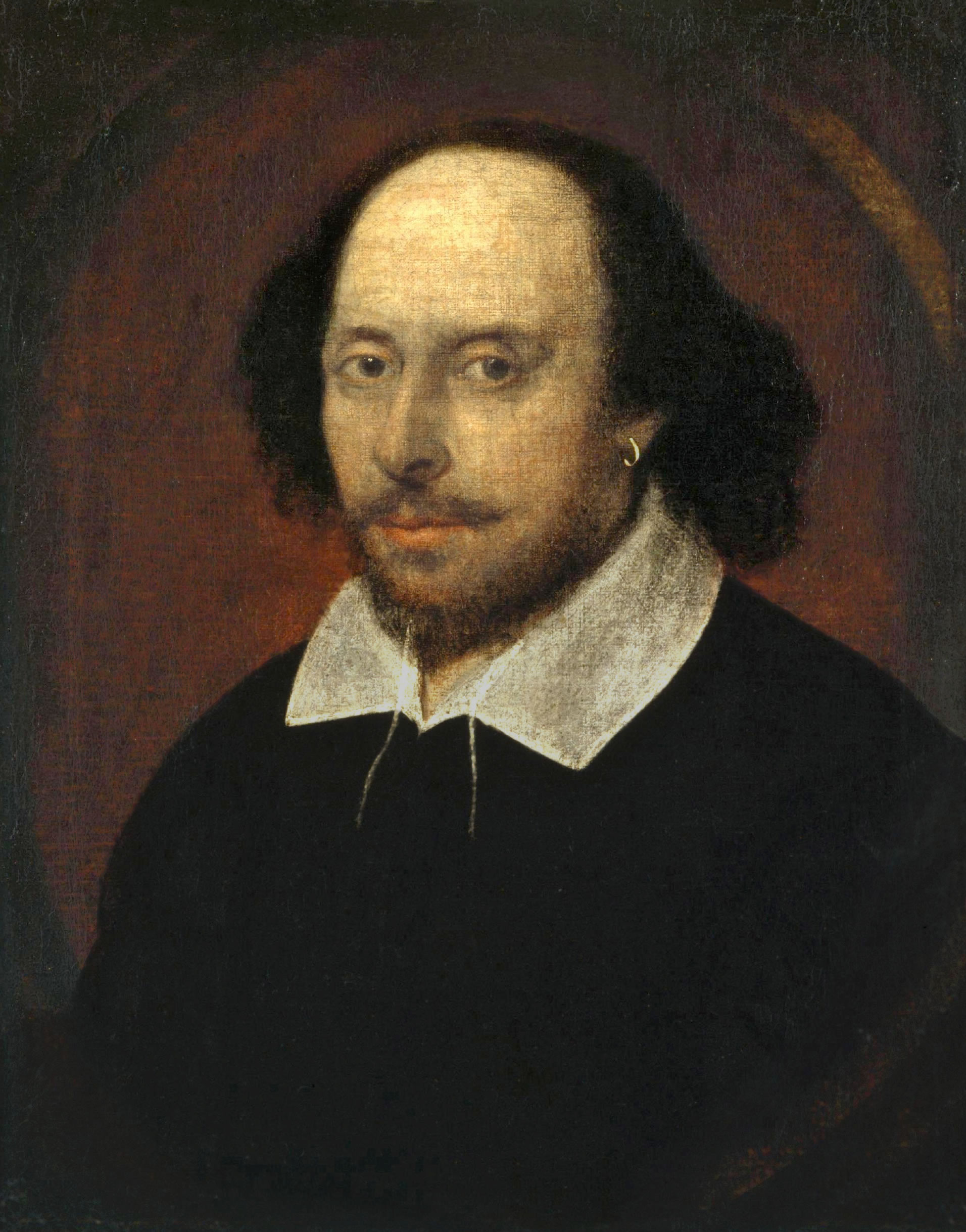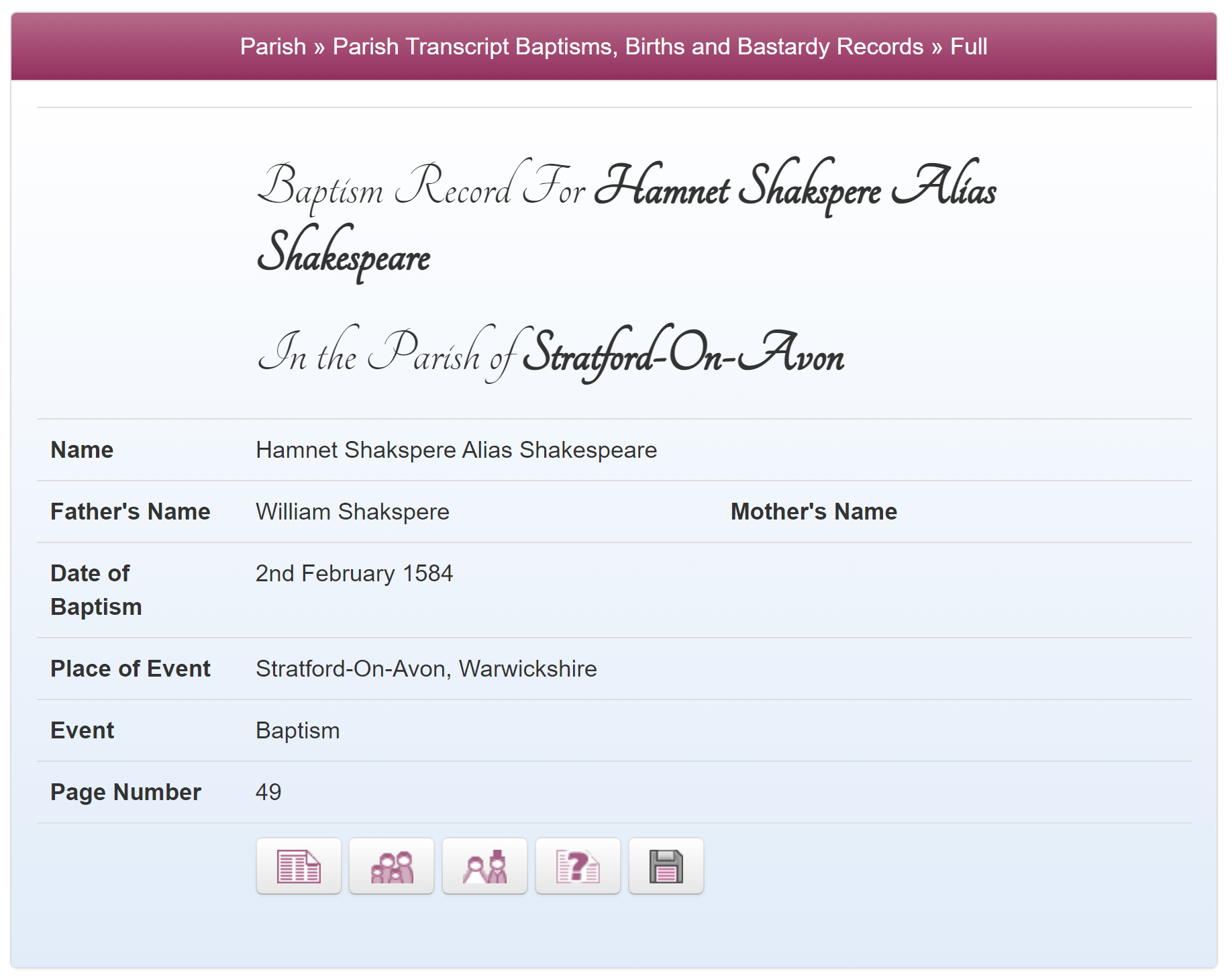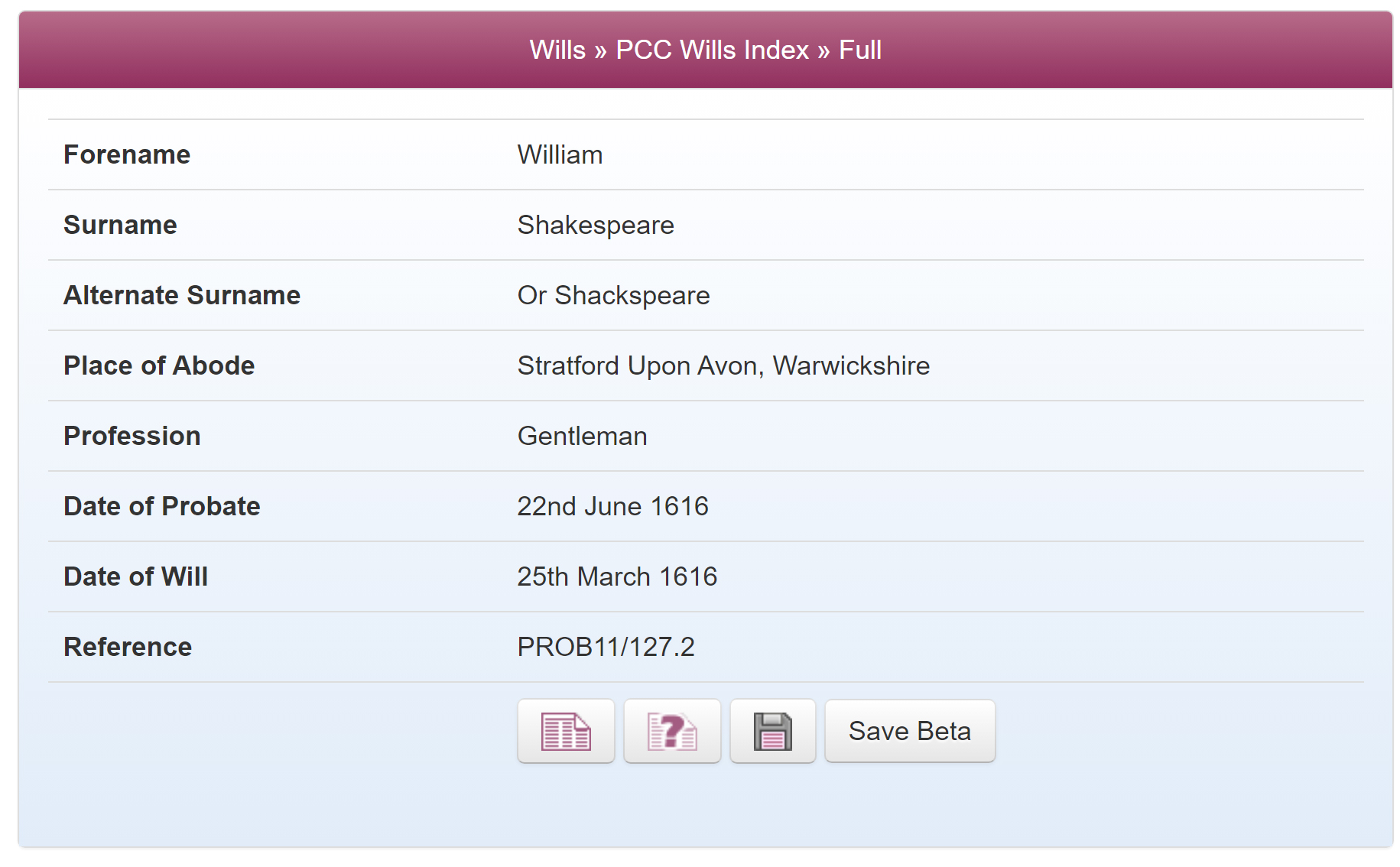
Most people are familiar with the work of William Shakespeare, but how many really know the man behind the name? For such a celebrity of the time, he had his mysterious side. His actual birth date is a matter of debate, there are a number of years when he simply disappeared out of view with rumours of becoming a school teacher and his wife was left out of his will. With the help of TheGenealogist, we delve deeper into the life of one of Stratford-on-Avon’s most famous sons.
His father was John Shakespeare, a glover and alderman from Snitterfield, Warwickshire and his mother was Mary Arden, the daughter of a wealthy farmer. John was supremely ambitious and became well known in local society, becoming Chamberlain of the Borough of Stratford in 1661.
A life shrouded in mystery and touched by scandal…

His actual date of birth is unknown but his baptism is recorded on the 26th April 1564. William was born in Stratford-upon-Avon, the third child of 8 and the eldest surviving son.
He married Anne Hathaway in haste suggesting a scandal, in Stratford-upon-Avon on the 27th November 1582, at the age of 18, she was 26, and the couple’s first child Susanna was born six months later. They also had twins Judith and Hamnet, baptised in 1583. However, Hamnet sadly died from unknown causes at the age of 11 and was buried in August 1596. The baptisms of Shakespeare’s children are shown in the Parish Records collection on TheGenealogist.co.uk.
Shakespeare’s career began to take off from around 1585 and he divided himself between his home life in Stratford-upon-Avon and his work as an actor, writer and part owner of a playing company known as the ‘Lord Chamberlain’s Men’ in London. From 1594 his plays were performed only by his own playing company, which became the leading company in London. Records of Shakespeare’s finances showed that the company had made him a very wealthy man and in 1597 he had purchased the second largest house in Stratford, called ‘New Place’. In 1599 the company were also able to build their own theatre on the south bank of the Thames, which was named ‘the Globe’.
Shakspeare, William, the great poet of nature, and the glory of the British nation, was descended of
a reputable family at Stratford-upon-Avon. His father was in the wool-trade, and dealt considerably that way. He had
[eight] children, of whom our immortal poet was the eldest…
Extract from Biographia
Dramatica,available at
TheGenealogist.co.uk and S&N Genealogy Supplies
TheGenealogist includes occupational records for many professions including teachers, clergy, law, medical professions and actors. Within this set of records is the ‘Biographia Dramatica’, which is a biographic record of actors, playwrights and their works from the 1500s to 1811. Entries include a background history and a record of their individual works with dates.
Whilst in London he appeared to move around a great deal, with his first residence being the parish of St Helen’s Bishopgate, north of the Thames. He later moved across the river to Southwark when the company built the Globe theatre. By 1604 he had returned back north of the river to an area north of St Paul’s Cathedral, where he rented rooms in a house belonging to a French Huguenot, Christopher Mountjoy, a maker of ladies wigs.
A scandal worthy of a character from one of his plays…
Shakespeare signed his last will and testament on the 25th March 1616 and a day later his new son-in-law, Thomas Quiney, was found guilty of fathering an illegitimate son by Margaret Wheler, who had died during child birth. Quiney was ordered by the church court to do public penance, which would have caused much shame and embarrassment for the Shakespeare family. Within a month of the scandal Shakespeare had died. He left behind him a substantial estate, the majority of which was left to his eldest daughter Susanna, who had married a physician named John Hall in 1607.
Access Over a Billion Records
Try a four-month Diamond subscription and we’ll apply a lifetime discount making it just £44.95 (standard price £64.95). You’ll gain access to all of our exclusive record collections and unique search tools (Along with Censuses, BMDs, Wills and more), providing you with the best resources online to discover your family history story.
We’ll also give you a free 12-month subscription to Discover Your Ancestors online magazine (worth £24.99), so you can read more great Family History research articles like this!

His will can be found under the name of William Shackspeare, in the PCC Wills available on TheGenealogist.co.uk. There are over 1 million records in the Prerogative Court of Canterbury wills and probate collection, which covers the years 1384 to January 1858. The records are copies of registered wills, which were written into volumes by the clerks at the church courts, and many earlier records are in Latin. TheGenealogist has now added over 200 years of records which will shortly be expanded to cover all years. The records are searchable by name, year of will, year of probate, area and profession. The search results also show the image of the original record.
Shakespeare’s Will instructed Susanna to pass the estate intact to ‘the first son of her body’. However she had only one child, a daughter Elizabeth, who married but died childless. The will strangely makes no reference to his wife Anne but it is presumed that she would have automatically inherited a third of the estate. His second daughter Judith had three children with Thomas Quiney, but all three died without marrying. His legacy therefore sadly ended with his grandchildren, but his name has continued to span centuries thanks to his many works, which include 38 plays, 154 sonnets and many other poems.
There have been regular features on William Shakespeare ever since. In the 1800s, the Illustrated London News devoted a number of articles to him. This included looking into his life and family in Stratford-upon-Avon. There were features on both his house and the house of his wife, with fascinating glimpses of the interior. TheGenealogist has a number of issues of the Illustrated London News, allowing us to really get a feel for how he lived.
The issue of 18th September 1847 of the Illustrated London News, has an in-depth feature of life in Stratford-upon-Avon, looking at the properties that Shakespeare owned, including the cottage of his wife Anne Hathaway, concluding with a visit to the churchyard where the Bard is buried near to his daughter Susanna and her husband. There’s a couple of issues on TheGenealogist with pages dedicated to the poet, giving a great insight into his life.
The story of one of the most famous poets and playwrights that Britain has ever had is an interesting one, providing a snapshot of the times. The legacy of the works he left behind was one that has transcended the centuries but it is interesting to see the lives of the family behind the famous ‘Bard’. Using documents from the time we can uncover invaluable information on an ancestor and provide an insight into the family business and relationships at the time. In the case of William Shakespeare, the fact his wife is not mentioned in his will is a curious matter, suggesting his wife had fallen out of favour or the couple were not close, an occurrence that the family historian may come across in their own personal research into their ancestors.
The direct descendants of William Shakespeare ended with his grandchildren who had no children themselves, but we are able to view his immediate family using TreeView. Click here to view the tree in TreeView .
We leave the final word to the ‘Bard of Avon’ himself…They say the owl was a baker’s daughter. Lord, we know
what we are, but know not what we may be.
–
Hamlet, Act IV Scene 5






